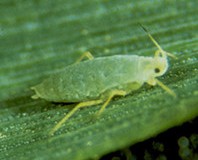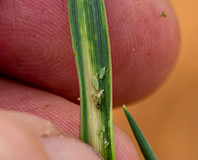Read the latest information on
Foot-and-mouth disease

Wingless adult Russian wheat aphid adult, showing lack of siphuncles (‘exhaust pipes’) and the presence of a ‘double tail’ end (cauda). Photo: Frank Peairs, Colorado State University, Bugwood.org
Following the decision that the newly arrived pest Russian wheat aphid (Diuraphis noxia) is not eradicable, growers are advised to seek advice from their department of agriculture or the Grains Research and Development Corporation (GRDC) about how to manage the pest in cereal crops.
The decision was made by the National Management Group on Russian wheat aphid (RWA) based on advice from the Consultative Committee on Emergency Plant Pests.
There are tools available to growers to help them control the aphid. An emergency use permit (82792) has been issued by the Australian Pesticide and Veterinary Medicines Authority which allows the use of pirimicarb and chlorpyrifos products for control of RWA in winter cereals. The specific use of these chemicals, however, depends on the state in which the crop is grown, so growers will need to contact their local authorities for further information.
The advice on managing the aphid is that, like other pests, growers should consider the economic thresholds of when to spray for RWA. International advice suggests an economic threshold of 20 per cent of seedlings infested up to the start of tillering and 10 per cent infested after that.
RWA can infest a large variety of cereal crops – wheat, barley, oats, rye, triticale and rice and other grass species.
It has a high dispersal potential, including being carried large distances by the wind, and on machinery, equipment and live plant material.
Although the aphid is considered a serious pest, it isn’t yet known how it will affect crops in Australia. There are many factors that will impact how well it does in our environment including natural enemies which attack RWA including parasitic wasps, ladybird beetles, lacewings, damsel bugs, hoverflies and fungi.

Russian wheat aphids on a leaf, showing damage to the leaf, and different forms and multiple generations of the aphid. Photo: Michael Nash, South Australian Research and Development Institute, a division of Primary Industries and Regions SA
Entomologists from the South Australian Research and Development Institute (SARDI) have already observed mummified and fungus infected RWA, and many of the RWA cases identified so far in South Australia have lower population density than the economic threshold.
Aphid populations are also strongly regulated by weather conditions. Rainfall and drying winds can kill RWA outside the shelter of leaf rolls, with heavy rain events able to cause 50 per cent mortality in the aphid.
Plant Health Australia has initiated the development of a management plan for RWA and will work with Grain Producers Australia, GRDC, the Australian Government and state and territory governments to deliver critical outcomes. The plan will include immediate control options, R&D to develop longer time control options and training to enhance early detection and best practice management.
The first case of RWA was identified in a wheat crop at Tarlee in South Australia’s Mid North on 13 May and it is now considered to be widespread in South Australia.
RWA is approximately two millimetres long, pale yellowish green with a fine waxy coating. The body is elongated compared with other cereal aphid species. It injects toxins into the plant while feeding, causing longitudinal rolling of leaves where the aphids shelter and whitish, yellowish to pink-purple chlorotic streaks along the length of the leaves. Plants with heavy infestations of RWA have their growth stunted with tillers lying almost parallel to the ground.
According to SARDI cereal pathologist Dr Hugh Wallwork, RWA does not seem to be a good transmitter of viruses.
For more information on RWA and control options go to the following websites: